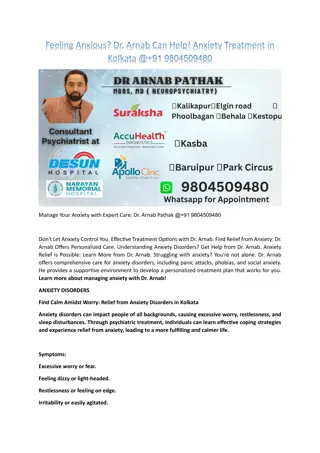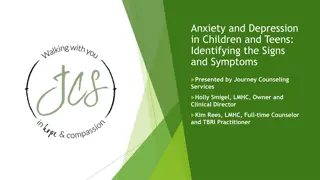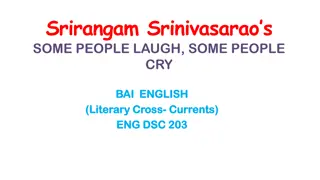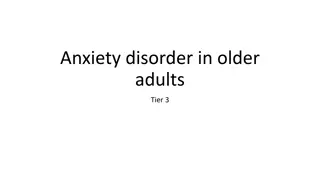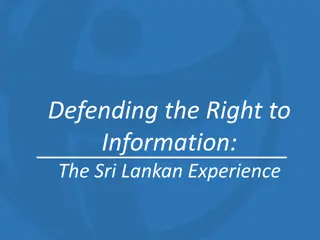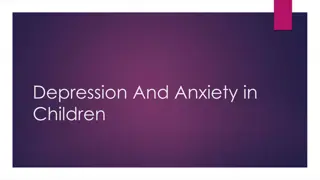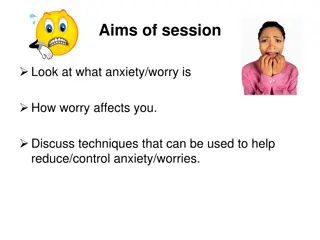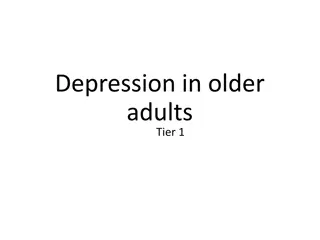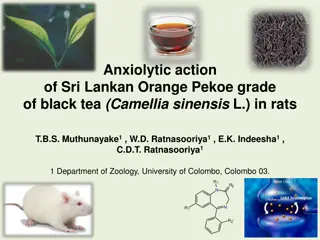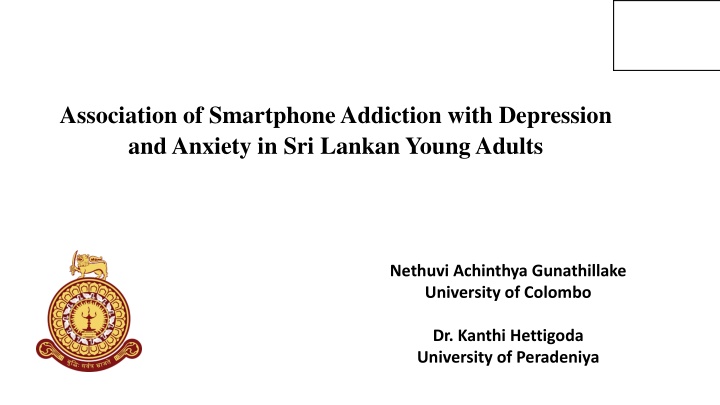
Exploring Smartphone Addiction, Depression, and Anxiety in Sri Lankan Young Adults
"Discover the link between smartphone addiction, depression, and anxiety in young adults in Sri Lanka. This study aims to understand the impact of smartphone usage on mental health in a new context. Explore definitions, objectives, and the rationale guiding this research."
Download Presentation

Please find below an Image/Link to download the presentation.
The content on the website is provided AS IS for your information and personal use only. It may not be sold, licensed, or shared on other websites without obtaining consent from the author. If you encounter any issues during the download, it is possible that the publisher has removed the file from their server.
You are allowed to download the files provided on this website for personal or commercial use, subject to the condition that they are used lawfully. All files are the property of their respective owners.
The content on the website is provided AS IS for your information and personal use only. It may not be sold, licensed, or shared on other websites without obtaining consent from the author.
E N D
Presentation Transcript
Association of Smartphone Addiction with Depression and Anxiety in Sri Lankan Young Adults Nethuvi Achinthya Gunathillake University of Colombo Dr. Kanthi Hettigoda University of Peradeniya
Rationale for the Study The extant literature on smartphone addiction has largely focused on adolescents (Chung et al., 2018; Mac C rthaigh et al., 2020; Zhou et al., 2021), and specific contexts like schools (Buctot et al., 2020; Lin & Liu, 2020, Wang et al., 2019) and universities (Demrici et al., 2015; Zhai et al., 2020; Zhang & Wu, 2020). To date, there is a distinct lack of research on smartphone addiction among young adults in general (context-free). No previous study has been conducted in Sri Lanka to investigate the association of smartphone addiction with depression and anxiety in Sri Lankan young adults. The majority of the past research on smartphone addiction and psychopathology has discussed depression and anxiety as consequences of smartphone addiction (Yang et al., 2020; Wrinkler et al., 2020), not as predictors of smartphone addiction.
Research Question Are depression and anxiety positively related to smartphone addiction in Sri Lankan young adults?
Aim and Objectives Aim: To investigate the association of smartphone addiction with depression and anxiety in Sri Lankan young adults. Objective: To translate the Smartphone Addiction Scale Short Version (Kwon et al., 2013) in to Sinhala and partially validate it among Sri Lankan young adults between the ages 18 and 25 years.
Definitions of the Study Variables 1. Smartphone Addiction The overuse of smartphones characterized by maladaptive dependency and a tendency to use the smartphone without being separated from it which results in functional impairments (Chen et al., 2019; Cho & Lee, 2017; Horwood & Anglim, 2019). 2. Depression The presence of sad, empty, or irritable mood, accompanied by somatic and cognitive changes that significantly affect the individual s capacity to function (APA, 2022). 3. Anxiety An emotional response (fear, tension, uneasiness, or restlessness) to the anticipation of future threats (APA, 2022).
Literature Review People seek emotional relief through easily accessible means such as smartphones, and overreliance on such negative coping mechanisms can lead to adverse consequences (Brand et al., 2016; Kardefelt-Winther, 2014). The constant connectivity to smartphones is an adaptive strategy to avoid feelings of insecurity or emotional distress (Zhou, et al, 2021). Depression and anxiety are positively associated with smartphone addiction in adolescents and university students (Demirci et al., 2015; Elhai et al., 2020; Kim et al., 2015; Rozgonjuk et al., 2018; Stankovi et al., 2021, Wang et al., 2018; Wolniewicz et al., 2019; Yang et al., 2020).
Research Hypotheses H1. Depression is positively related to smartphone addiction H2. Anxiety is positively related to smartphone addiction
Methodology Research Design - cross-sectional, non-experimental, and quantitative Sample - Sri Lankan young adults aged 18-25 years Sample Size - 786 Sampling Technique - convenience sampling, snowball sampling Inclusion Criteria - Literate in either English or Sinhalese languages, Using a personal smartphone (a smartphone which was not merely used for work) Exclusion Criteria - Illiterate, Using the personal smartphone for less than 30 minutes per day, physically or mentally unwell at the time of the survey
Study Variables - Independent Variables - 1) Depression 2) Anxiety Dependent Variable - Smartphone Addiction Data Collection Method - online survey Participant Recruitment Procedure - A structured online questionnaire was created using Google Forms, and the web link for the survey questionnaire was shared via social media platforms.
Instruments - 1. Smartphone Addiction 10-item Smartphone Addiction Scale Short Version (SAS-SV) (Kwon et al., 2013; Cronbach s = .91) 2. Depression and Anxiety Depression and Anxiety subscales of DASS-21 (Lovibond & Lovibond, 1995; Aththidiye, 2012; Cronbach s = .83 for depression Cronbach s = .76 for anxiety) Note. Both the English and Sinhala versions of the scales were used.
Data Analysis - 1. Correlation Analysis To assess the strength and direction of the linear relationship among variables. 2. Multiple Linear Regression Analysis To determine the proportion of the variance in the outcome variable (smartphone addiction) that can be explained by the predictor variables (depression and anxiety). 3. Reliability Analysis To find the internal consistency of the translated SAS-SV scale, DASS-21 Sinhala version, the original SAS-SV English version and the original DASS-21 English version in the present study.
Results Table 1 Demographic Characteristics of the Study Sample (n = 786) Characteristic n % Age 18 19 20 21 22 23 24 25 108 100 91 75 54 64 118 176 13.7 12.7 11.6 9.5 6.9 8.1 15.0 22.4
Characteristic n % Sex Male Female 389 397 49.5 50.5 Current Employment Status Employed full-time Employed part-time Self-employed Unemployed 193 97 38 458 24.6 12.3 4.8 58.3
Characteristic n % Current Educational Status Studying A/L Following a foundation course/certificate course/diploma Following an undergraduate degree or equivalent qualification Following a postgraduate degree Currently not engaged in studies 237 75 294 51 129 30.2 9.5 37.4 6.5 16.4 Main purpose of using the smartphone To use social media To make phone calls to friends and family For studies For work To play games For online shopping 477 59 180 36 25 9 60.7 7.5 22.9 4.6 3.2 1.1
Characteristic n % Number of hours used per day 30 minutes 1 hour 1-2 hours 2-3 hours 3-4 hours 4-5 hours 5-6 hours More than 6 hours 52 140 159 125 97 70 143 6.6 17.8 20.2 15.9 12.3 8.9 18.2 Mode of connecting to internet Using a personal Wi-Fi connection Using an institutional (office/university) Wi-Fi connection Using mobile data 462 12 312 58.8 1.5 39.7
Table 2 Means, Standard Deviations, the Minimum, and the Maximum Scores of Smartphone Addiction, Depression and Anxiety Variable Score Range M SD Min Max Smartphone Addiction 10 - 60 34.09 10.24 10 60 Depression 0 - 42 10.78 10.96 0 42 Anxiety 0 - 42 6.57 8.72 0 42 Note. M = Median, SD = Standard Deviation, Min = Minimum Score, Max = Maximum Score
Table 3 Results of the Spearman Correlation Analysis Proposed Relationship rs Depression Smartphone Addiction .58 Anxiety Smartphone Addiction .45 Note. * p < .01 Proposed direction of the relationship positive
Table 4 Results of the Reliability Analysis Scale/Subscale Cronbach s alpha SAS-SV Sinhala scale .87 SAS-SV English scale .83 DASS-21 Sinhala depression subscale .92 DASS-21 English depression subscale .88 DASS-21 Sinhala anxiety subscale .89 DASS-21 English anxiety subscale .84
Table 5 Model Summary of the Multiple Regression Analysis R2 Adjusted R2 Model R Predictor Variables .58 .34 .34 Note. Predictor Variables depressive, anxiety Outcome Variable smartphone addiction The model accounted for 58% of variance in smartphone addiction (R2 = .58, F(2, 783) = 197.47, p < .001). Depression ( = .48, t(783) = 12.72, p < .001) and anxiety ( = .10, t(783) = 2.12, p = .034) significantly predicted smartphone addiction, at 95% confidence level.
When the number of hours of using the smartphone per day was used as a control variable in the model, the model accounted for 65% of the variance in smartphone addiction (R2 = .65, F(3, 782) = 190.91, p < .001). Depression ( = .42, t(782) = 11.71, p < .001) and anxiety ( = .10, t(783) = 2.15, p = .032) significantly predicted smartphone addiction, at 95% confidence level.
Discussion Hypothesis 1 Supported Consistent with the findings of Demrici et al., 2015; Elhai et al., 2020; Jin et al., 2021; Rozgonjuk et al., 2021. Hypothesis 2 Supported Consistent with the findings of the past research Demrici et al., 2015; Elhai et al., 2020; Jin et al., 2021; Rozgonjuk et al., 2021.
Strengths - Large sample size (n =786). High generalizability. Equal representation of males (49.5%) and females (50.5%). All the scales produced high internal consistency reliability (Cronbach s alpha <.80). Quality of data assured. Anonymity and confidentiality guaranteed. Limitations - Online data collection Convenience sampling Only using two subscales of DASS-21
Implications - Addressing the underlying psychological issues of smartphone addicts such as depression and anxiety with appropriate assessment and intervention . Educating young adults to use smartphones productively instead of using it as a negative coping mechanism to relieve psychological distress.
Conclusion Depression and anxiety are significantly and positively related to smartphone addiction among Sri Lankan young adults between the ages 18-25 years. The translated SAS-SV Sinhala version has high content and consensual validity, and high internal consistency reliability in the study sample.
References American Psychiatric Association. (2022). Diagnostic and statistical manual of mental disorders (5th ed., text rev.). Aththidiye, A.V.S. R. (2012, August 18). Adaptation and validation of the depression anxiety and stress scale (DASS21) among students in the university of Colombo. Annual research symposium, university of Colombo. Brand, M., Wegmann, E., Stark, R., M ller, A., W lfling, K., Robbins, T. W., & Potenza, M. N. (2019). The Interaction of Person-Affect-Cognition-Execution (I-PACE) model for addictive behaviors: Update, generalization to addictive behaviors beyond internet-use disorders, and specification of the process character of addictive behaviors. Neuroscience & Biobehavioral Reviews, 104, 1 10. https://doi.org/10.1016/j.neubiorev.2019.06.032 Buctot, D. B., Kim, N., & Kim, S. H. (2020). The Role of Nomophobia and Smartphone Addiction in the Lifestyle Profiles of Junior and Senior High School Students in the Philippines. SSRN Electronic Journal. Published. https://doi.org/10.2139/ssrn.3571366 Demirci, K., Akg n l, M., & Akpinar, A. (2015). Relationship of smartphone use severity with sleep quality, depression, and anxiety in university students. Journal of Behavioral Addictions, 4(2), 85 92. https://doi.org/10.1556/2006.4.2015.010 Elhai, J. D., Yang, H., McKay, D., & Asmundson, G. J. (2020). COVID-19 anxiety symptoms associated with problematic smartphone use severity in Chinese adults. Journal of Affective Disorders, 274, 576 582. https://doi.org/10.1016/j.jad.2020.05.080
Kwon, M., Kim, D. J., Cho, H., & Yang, S. (2013b). The Smartphone Addiction Scale: Development and Validation of a Short Version for Adolescents. PLoS ONE, 8(12), e83558. https://doi.org/10.1371/journal.pone.0083558 Lin, Y., & Liu, Q. (2020). Perceived subjective social status and smartphone addiction tendency among Chinese adolescents: A sequential mediation model. Children and Youth Services Review, 116, 105222. Lovibond, P., & Lovibond, S. (1995). The structure of negative emotional states: Comparison of the Depression Anxiety Stress Scales (DASS) with the Beck Depression and Anxiety Inventories. Behaviour Research and Therapy, 33(3), 335 343. https://doi.org/10.1016/0005-7967(94)00075-u Winkler, A., Jeromin, F., Doering, B. K., & Barke, A. (2020). Problematic smartphone use has detrimental effects on mental health and somatic symptoms in a heterogeneous sample of German adults. Computers in Human Behavior, 113, 106500. https://doi.org/10.1016/j.chb.2020.106500 Yang, J., Fu, X., Liao, X., & Li, Y. (2020). Association of problematic smartphone use with poor sleep quality, depression, and anxiety: A systematic review and meta-analysis. Psychiatry Research, 284, 112686. https://doi.org/10.1016/j.psychres.2019.112686 Zhai, X., Ye, M., Wang, C., Gu, Q., Huang, T., Wang, K., Chen, Z., & Fan, X. (2020). Associations among physical activity and smartphone use with perceived stress and sleep quality of Chinese college students. Mental Health and Physical Activity, 18, 100323. https://doi.org/10.1016/j.mhpa.2020.100323
Appendix 1. Smartphone Addiction 10-item Smartphone Addiction Scale Short Version (SAS-SV) (Kwon et al., 2013) Rating Scale: 1 = Strongly Disagree 6 = Strongly Agree Sample Items: Missing planned work due to smartphone use Having my smartphone in my mind even when I am not using it .
2. Depression and Anxiety 21-item Depression Anxiety Stress Scale (DASS-21) (Lovibond & Lovibond; 1995) Rating Scale: 0 = Did not apply to me at all 3 = Applied to me very much or most of the time Sample Items: Icouldn t seem to experience any positive feeling at all (depression) I was aware of dryness of my mouth (anxiety)






